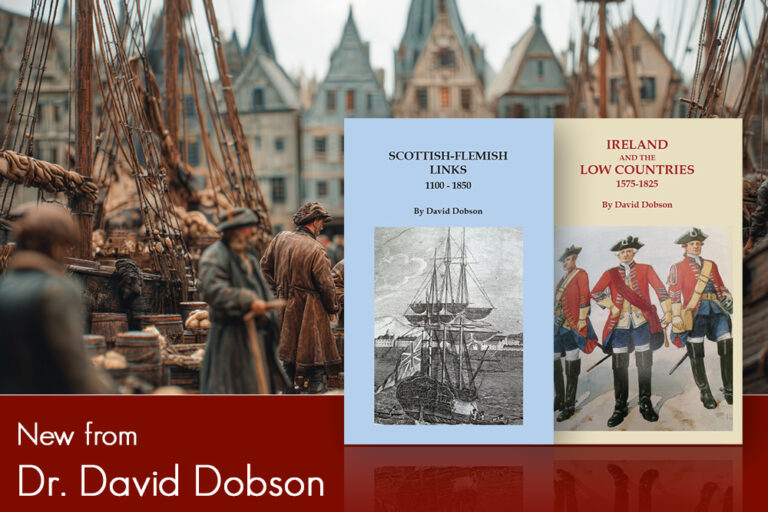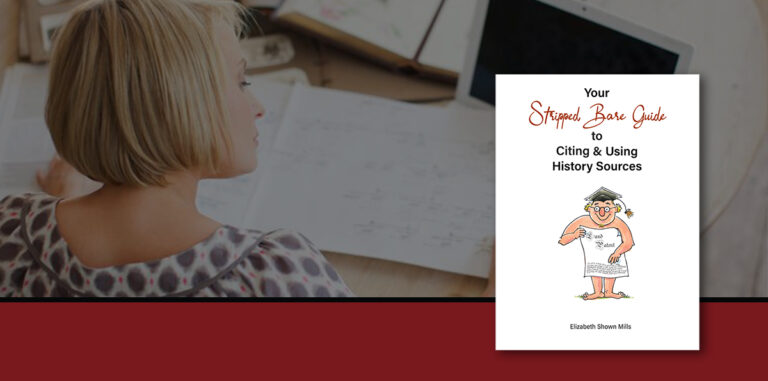
Problem Analysis from Professional Genealogy: Preparation, Practice & Standards
Professional Genealogy: Preparation, Practice & Standards is edited by Elizabeth Shown Mills and written by a new generation of genealogical educators. This important publication represents an entirely new guide to the profession of genealogy–offering fresh insights and new specialties, grounded in more-solid standards and wider experiences and applications. In twenty-six chapters and nearly 700 pages, Progen PPS is an invaluable resource for professional genealogists and students, as well as all family history researchers. “From genetic and forensic genealogy to ethics and contracts, business structures, marketing, writing, editing, and preparing books for press, ProGen PPS promises to inspire thought processes and ignite new discussions” (Billie Stone Fogarty, M. Ed. President, Association of Professional Genealogists).
To illustrate the value and power of Progen PPS, we have excerpted a portion of Chapter 13 on Problem Analysis and Research Plans, prepared by Laura Murphy DeGrazia, CG.
PROBLEM ANALYSIS
Effective problem analysis requires a thorough understanding of three key issues. First, we must know the relevant available sources for that problem—their accessibility, arrangement, content, and varying degrees of reliability. Second, we must have a sound grasp of evidence-analysis principles (see chapter 12) and strong correlation skills. Third, we must be well-versed in a variety of methodological approaches for extracting evidence that has heretofore gone unobserved.
During analysis, we scrutinize the components of the research problem. We consider what is known about the subject and what we want to learn. We break apart the assertions, assess the supporting evidence, and decide whether some or all of it needs to be strengthened. We seek gaps in research, flaws in logic, errors in interpretation, and too-hastily drawn conclusions. We look for opportunities to advance the research through additional sources or new approaches. At the conclusion of the analysis phase, we should have a thorough understanding of the problem and the existing evidence—as well as ideas for moving the research toward a resolution of the problem.
ORGANIZATION & REVIEW
All research questions have starting-point data. Whether that starting point be a single piece of information or a conclusion based on earlier research, we must evaluate what is known, how it is known, and how it relates to the current problem. We begin by familiarizing ourselves with the research that already has been done and the evidence that can be drawn from it. If we have worked on the project in the past, we may have the necessary material at hand. If the project is for a new client, we must rely on the client’s understanding of genealogical fundamentals to provide the necessary data. We may need to ask for everything gathered to date and sort through it on our own.
Unless we are given only one or two pieces of information, we will probably have to make several passes through the client’s material, with each pass focusing on a different characteristic or task. Our approach will likely vary from one project to another, depending upon the nature of the material. A relatively common project might entail the following steps, each of which represents a separate pass-through of the client’s materials:
1. Read all materials to become familiar with their content. Clients compile and send their information in many different ways. Some present their findings in narrative form, while some will send copies of documents containing scribbled notes and explanations. Others will share copies of research reports prepared by professionals. A preliminary review of the material helps us understand the level of work that has been done on the problem and provides an overview of the data.
2. Identify information and searches that are relevant to the subject and problem. Just as clients’ organization and presentation styles vary, so does their ability to determine relevance. If a client sends everything available without properly separating out irrelevant items, the responsibility of the culling process falls to us.
3. List sources consulted and summarize the findings, whether negative or positive. Here, we strive for complete citations to identify each source as fully as possible. We include search parameters for indexes, databases, and online searches. By identifying exactly what a client used, we have a base point for determining the quality of the evidence that the client is relying upon. This list may be created in genealogical software, in a word-processor document, or in handwritten notes, depending on personal preference. Preparing the list in software will simplify future work, as details can then be easily cut-and-pasted elsewhere.
4. Compile a biographical sketch (or genealogical summary) and timeline for the individual to be studied. Using the list of sources and summarized findings, we document each point. By organizing information scattered across various documents and connecting assertions with sources, we can better see where documentation is weak or missing. In our sketch, we need to include all provided information about the subject’s occupation, religion, parents, and lineage—as well as the spouse, spouse’s parents, and children. In the timeline, we chronicle each known activity: not just census appearances but also civic and court actions, land purchases and sales, migration, military service, and so on. We comment upon errors, questions, and other observations. We add comments to the source citations to address anomalies in the records.
Appendixes to this chapter provide three examples to illustrate these work products. Appendix 13-1 depicts a concise biographical sketch. Appendix 13-2 demonstrates the corresponding timeline. Appendix 13-3 offers an alternative format for organizing biographical data and known life events in a different family, time, and place. Different situations call for different approaches.
5. Create analytical notes. As we make passes through the client’s materials, we make commentaries. We may keep all of our comments together, or create a separate sheet for each category—reminders, general concerns, observations, questions for the client, and so on. These notes will include statements such as the following:
Why does client say John’s father was Tom? What’s the evidence?
- Were land records searched? I see no mention of them.
- Client cites abstracts of vital records. Did she check the originals?
- What evidence documents the assertion that the man in Chicago in 1875 is the same man who lived in Virginia thirty years earlier?
- Client assumes that the children in the 1850 census are all children of the household head. Does she have other evidence to confirm that?
- Several Dubois families appear nearby in multiple places. Is this a coincidence or a possible connection?
6. Identify associates. During this phase, we might record information about people connected to the subject. As we review copies of client-provided sources and reports, we might create a multi-column work-sheet on which we record the names of associates, their relationships, and the source citations that support the evidence. Because some associates’ names will appear multiple times, it is helpful to maintain this list in a word processor or spreadsheet that can be sorted.
7. Create other needed aids. Illustrations such as charts, family trees, and maps may also be produced during this information-organization stage. Most genealogy software can produce family group sheets and trees, and some programs have mapping capability. Entering the baseline data into genealogy software can help us understand the family structure. (However, we should not undertake extensive data entry unless the client has specifically asked us to maintain a database. Most clients prefer to do their own, using their software of choice, and our particular client may have already done this.)
When we are satisfied that we have obtained all the available information from the client, and that we have adequately organized and summarized it, we move on to the next step: a deep evaluation.
DEEP EVALUATION
If information about the subject of the research lies on shaky ground, it would be unwise to move forward. All of our labor might be based on errors and misstatements. We cannot just accept a client’s starting point as ac-curate and sufficiently proven. We must evaluate the supporting evidence ourselves to ensure that the basis for further work is sound.
Each assertion about the subject must satisfy the GPS. We evaluate each assertion with respect to whether
- reasonably exhaustive research has been conducted, with emphasis on original sources and primary information;
- full documentation and complete citations are provided for each “fact”;
- adequate analysis and correlation have tested each assertion;
- conflicts (if any) have been resolved;
- the conclusion is soundly reasoned and clearly explained.
In this phase, we compare and contrast the client’s assertions with our own conclusions and interpretations. We review the biographical sketch and individual timeline, illustrations, and lists compiled during review and organization. We cull those comments, observations, and questions into a more refined overall evaluation of the starting point, focusing on its strength or weakness as a basis for continued research. Some of the elements we consider during this deep analysis are as follows:
1. Missing documentation. Assertions made without identification of the supporting evidence cannot be evaluated as reliable or unreliable. If the client is unable to identify the relevant sources, then undocumented statements may have to be explored before the agreed-upon research question can be satisfactorily addressed.
2. Misread or misinterpreted sources. If details in previously examined materials have been misread or misinterpreted, the starting point information provided by the client could be incorrect. Erroneously interpreted names and dates are especially problematic, as the client may have re-lied on those incorrect readings to direct further research. Also, less experienced researchers can easily overlook subtle clues that suggest avenues for research.
3. Unused or incompletely used sources. When we are well informed about the sources pertinent to the time and place, we may notice that potentially helpful sources have been overlooked. Similarly, we may see that earlier searches were based on too-narrow parameters or perhaps focused on one resource, index, or methodology without considering other means of entry to the same collection.
4. Poor selection of sources. We take notice not only of sources used, but of their quality and the reliability of their underlying information. Some clients do not differentiate between weak and strong sources, and there-fore make poor choices. For example, they might have relied on a will abstract without checking the original court records or used error-laden transcriptions of church records, unaware of problems well known to more seasoned genealogists. Correcting this deficiency would not be redundant. Better versions of the sources often result in more-accurate findings and in helpful clues that point to other paths to explore.
5. Errors in analysis and correlation. As we assess the client’s use of the materials, we look for weaknesses in the body of evidence, gaps or flaws in reasoning, and faulty presumptions. Connections and contradictions may have gone unnoticed. Or, connections may have been presumed from insufficient evidence. After correcting the errors to reach more reliable conclusions, additional research may or may not be needed. Some-times, correcting errors in analysis and correlation will actually resolve the client’s problem without the need for additional research.
6. Too-broad or too-narrow search focus. We consider the extent of previous research and whether it was sufficiently targeted and of appropriate scope. We look for places where expanding the search might lead to a solution, to confirmation of a hypothesis, or to records of people and places that may yield useful information.
This detailed evaluation will produce one or more lists of comments, observations, and ideas from which we make a final, overall assessment of the starting point. If some evidence supporting key assertions is too weak, we must redefine the research question to address those problems. This may require us to resolve errors in interpretation, correct flaws in logic, explore unused sources, test a proposed conclusion, replace weak sources with stronger ones, or fill gaps in the subject’s life. At this point, we need to communicate our concerns to the client and ensure that the client understands the reasons why we suggest a change in the focus of research.
Once we are confident that our starting-point data is sound, we can move forward with the development of a work plan for productive research.
RESEARCH PLANS
DEFINING WORKABLE STRATEGIES
With a well-defined, soundly based research focus, we select methods and sources to address the problem. Strategies fall into one or more of the following broad categories.
Examine unused sources
During the review and analysis, we likely identified one or more unexplored sources that could yield relevant evidence. These might include materials directly related to the subject or the subject’s associates, or sources of general information that will enhance contextual understanding of the subject’s world—laws, maps, and community and social histories, for example. We expect to use unexplored sources at the beginning stage of a new problem; but even after extensive research has been conducted, we may discover some source or sources that have been overlooked or have not been fully investigated.
Revisit previously used sources
If errors or weaknesses in source usage are seen or suspected (for example, misread data, overlooked clues, inaccurate interpretations, or reliance on derivative versions of sources), those issues should be addressed before moving on to additional, unused sources. We might opt to examine a different version of the source, perhaps replacing a derivative record with the original that is likely to provide more-accurate information. We might be aware that the same record collection can be searched via multiple ways. By exploiting methods of reexamination, we may find new information in that source. Examples of this include using indexes to find books of individual deed books in both the repository and on microfilm, then reading those books page by page rather than relying on an index, and consulting multiple indexes to the same records when those indexes include different identifying details and search fields.




